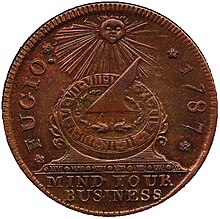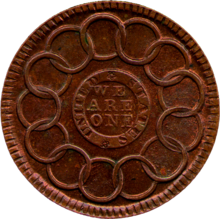Fugio cent
This article needs additional citations for verification. (April 2013) |
United States | |
| Value | 0.01 U.S. dollar |
|---|---|
| Mass | 10.2 g |
| Composition | Cu |
| Obverse | |
 | |
| Design | ""Mind Your Business"" Sun and Sun dial |
| Designer | Benjamin Franklin |
| Design date | 1787 |
| Reverse | |
 | |
| Design | "We Are One", 13 State Chain Links |
| Designer | Benjamin Franklin |
| Design date | 1787 |
The Fugio Cent is the first official one-cent piece of United States currency. Consisting of 0.36 oz of copper, its design was inspired by the works of Benjamin Franklin. While very available in lower grades, rare examples in excellent condition are highly sought after by collectors.
History

On April 21, 1787, the Congress of the Confederation of the United States authorized a design for an official copper penny,[1] later referred to as the Fugio cent because of its image of the sun shining down on a sundial with the caption, "Fugio" (Latin: I flee/fly). This coin was reportedly designed by Benjamin Franklin; as a reminder to its holders, he put at its bottom the message, "Mind Your Business." The image and the words form a rebus meaning that "time flies, do your work." This design was also used on the "Continental dollar" (issued as coins of unknown real denomination, and in paper notes of different fractional denominations) in February 1776.[2]
Some historians believe that the word "business" was intended literally here, as Franklin was an influential and successful businessman. Given Franklin's history publishing aphorisms, it may have been intended to mean both monetary and social business.
The reverse side of both the 1776 coins and paper notes, and the 1787 coins, bore the third motto "We Are One" (in English) surrounded by thirteen chain links, representing the original thirteen colonial states.
Following the reform of the central government with the 1789 ratification of the 1787 Constitution, gold and silver coins transitioned to the motto "E pluribus unum" from the Great Seal of the United States.
See also
- Bank of New York Hoard
- Large cent (United States coin)
- History of the United States dollar
- United States dollar
- United States Note
References
- ^ Norton, Frank Henry; et al. (1875). "Notes and Queries". American Journal of Numismatics. 10 (1): 21. Retrieved 25 April 2016.
- ^ "The Story of Money: 11--Coin Design Inspired Fugio Cent". Federal Reserve Bank of Atlanta. Retrieved 28 August 2016.
External links
- The Fugio Cent of 1787: Introduction, The Coins of Colonial and Earlier America.
- U.S. Mint: Circulating Coins FAQ
- U.S. Mint: 1776 Continental "Dollar"
